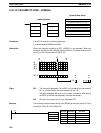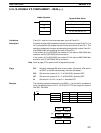
227
5-18-16 DOUBLE 2’S COMPLEMENT – NEGL(––)
S: First source word
IR, SR, AR, DM, HR, TC, LR
Ladder Symbols
Operand Data Areas
R: First result word
IR, SR, AR, DM, HR, LR
NEGL(––)
S
R
---
Limitations S and S+1 must be in the same data area, as must R and R+1.
Description Converts the eight-digit hexadecimal content of the source words (S and S+1) to
its 2’s complement and outputs the result to the result words (R and R+1). This
operation is effectively the same as subtracting the eight-digit content S and S+1
from $0000 0000 and outputting the result to R and R+1.
If the content of S is 0000 0000, the content of R will also be 0000 0000 after
execution and EQ (SR 25506) will be turned on.
If the content of S is 8000 0000, the content of R will also be 8000 0000 after
execution and UF (SR 25405) will be turned on.
Note Refer to page 27 for details on 32-bit signed binary data.
Flags ER: Indirectly addressed DM word is non-existent. (Content of DM word is
not BCD, or the DM area boundary has been exceeded.)
EQ: ON when the content of S+1, S is 0000 0000; otherwise OFF.
UF: ON when the content of S+1, S is 8000 0000; otherwise OFF.
N: ON when bit 15 of R+1 is set to 1; otherwise OFF.
Example The following example shows how to use NEGL(––) to find the 2’s complement
of the hexadecimal value in LR 21, LR 20 (001F FFFF) and output the result to
DM 0021, DM 0020.
NEG(––)
LR20
DM 0020
---
00000
Address Instruction Operands
00000 LD 00000
00001 NEGL(––)
LR 20
DM 0020
0000
001F
FFE0
–
0000
FFFF
0001
S+1: LR 21 S: LR 20
R+1: DM 0021 R: DM 0020
Data Conversion Section 5-18


















